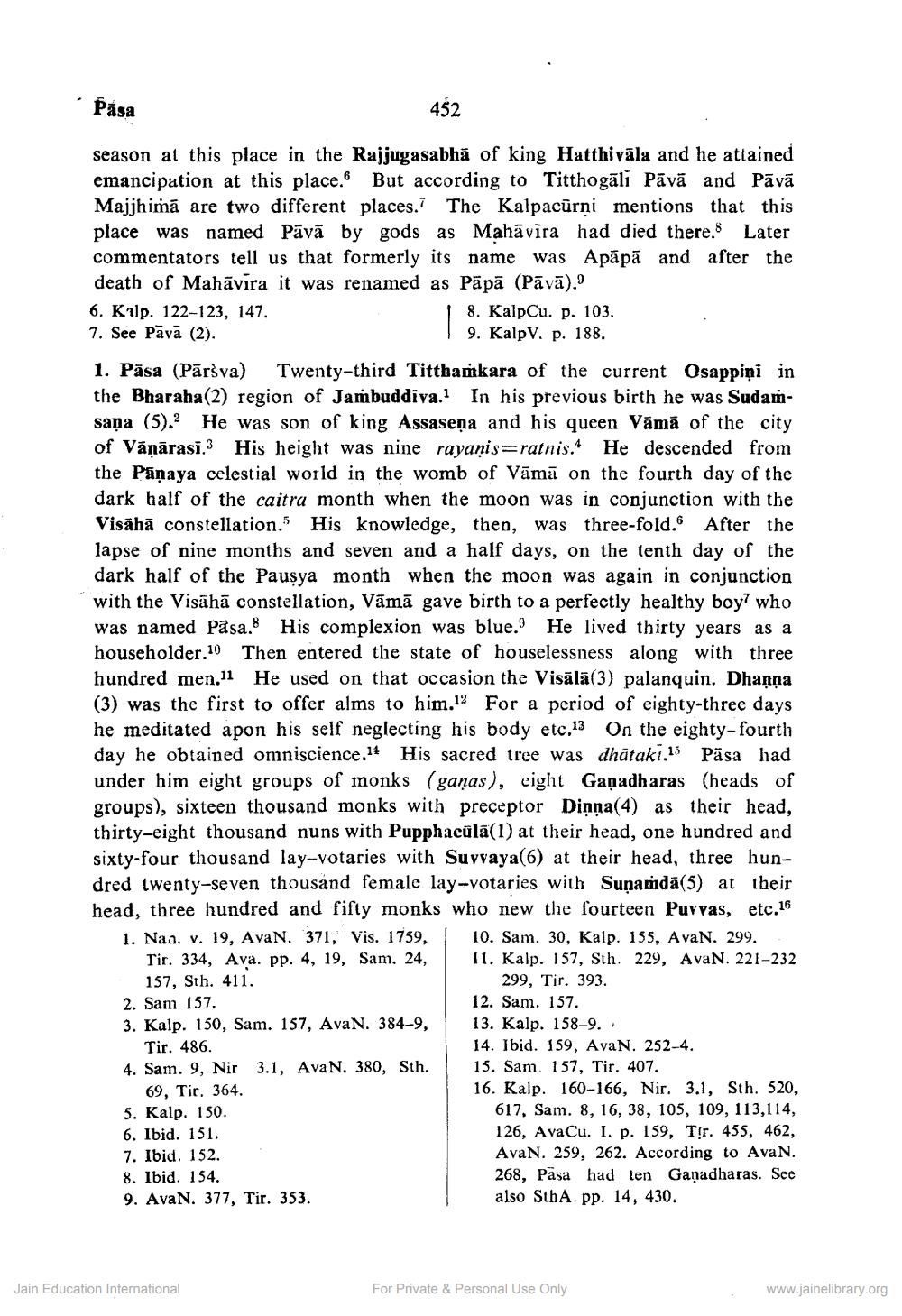________________
Pása
452
season at this place in the Rajjugasabhā of king Hatthivāla and he attained emancipation at this place. But according to Titthogāli Pāvā and Pāvā Majjhimā are two different places. The Kalpacūrni mentions that this place was named Pāvā by gods as Mahāvīra had died there. Later commentators tell us that formerly its name was Apāpā and after the death of Mahāvira it was renamed as Pāpā (Pāvā).9 6. Kilp. 122–123, 147.
18. KalpCu. p. 103. 7. See Pavā (2).
19. KalpV. p. 188.
1. Pāsa (Pārsva) Twenty-third Titthamkara of the current Osappiņi in the Bharaha(2) region of Jambuddiva. In his previous birth he was Sudamsaņa (5). He was son of king Assaseña and his queen Vāmā of the city of Vāņārasi. His height was nine rayanis=ratnis. He descended from the Paņaya celestial world in the womb of Vāmā on the fourth day of the dark half of the caitra month when the moon was in conjunction with the Visāhā constellation. His knowledge, then, was three-fold. After the lapse of nine months and seven and a half days, on the tenth day of the dark half of the Pausya month when the moon was again in conjunction with the Visāhā constellation, Vāmā gave birth to a perfectly healthy boy who was named Pasa. His complexion was blue. He lived thirty years as a householder.10 Then entered the state of houselessness along with three hundred men.11 He used on that occasion the Visālā(3) palanquin. Dhaņņa (3) was the first to offer alms to him.12 For a period of eighty-three days he meditated apon his self neglecting his body etc.13 On the eighty-fourth day he obtained omniscience.14 His sacred tree was dhātakı.15 Päsa had under him eight groups of monks (ganas), eight Gañadharas (heads of groups), sixteen thousand monks with preceptor Diņņa(4) as their head, thirty-eight thousand nuns with Pupphacülā(1) at their head, one hundred and sixty-four thousand lay-votaries with Suvvaya(6) at their head, three hundred twenty-seven thousand female lay-votaries with Suņamdā(5) at their head, three hundred and fifty monks who new the fourteen Puvvas, etc. 16 1. Nao. v. 19, AvaN. 371, Vis. 1759, 10. Sam. 30, Kalp. 155, AvaN. 299.
Tir. 334, Ava. pp. 4, 19, Sam. 24, 11. Kalp. 157, Sth. 229, AvaN. 221-232 157, Sth. 411.
299, Tir. 393. 2. Sam 157.
12. Sam. 157. 3. Kalp. 150, Sam. 157, AvaN. 384-9, 13. Kalp. 158-9. Tir. 486.
14. Ibid. 159, AvaN. 252-4. 4. Sam. 9, Nir 3.1, AvaN. 380, Sth. 15. Sam. 157, Tir. 407. 69, Tir. 364.
16. Kalp. 160-166, Nir. 3.1, Sth. 520, 5. Kalp. 150.
617, Sam. 8, 16, 38, 105, 109, 113,114, 6. Ibid. 151.
126, AvaCu. I. p. 159, Tir. 455, 462, 7. Ibid. 152.
AvaN. 259, 262. According to AvaN. 8. Ibid. 154.
268, Pasa had ten Ganadharas. See 9. Avan. 377, Tir. 353.
also SthA. pp. 14, 430.
Jain Education International
For Private & Personal Use Only
www.jainelibrary.org




